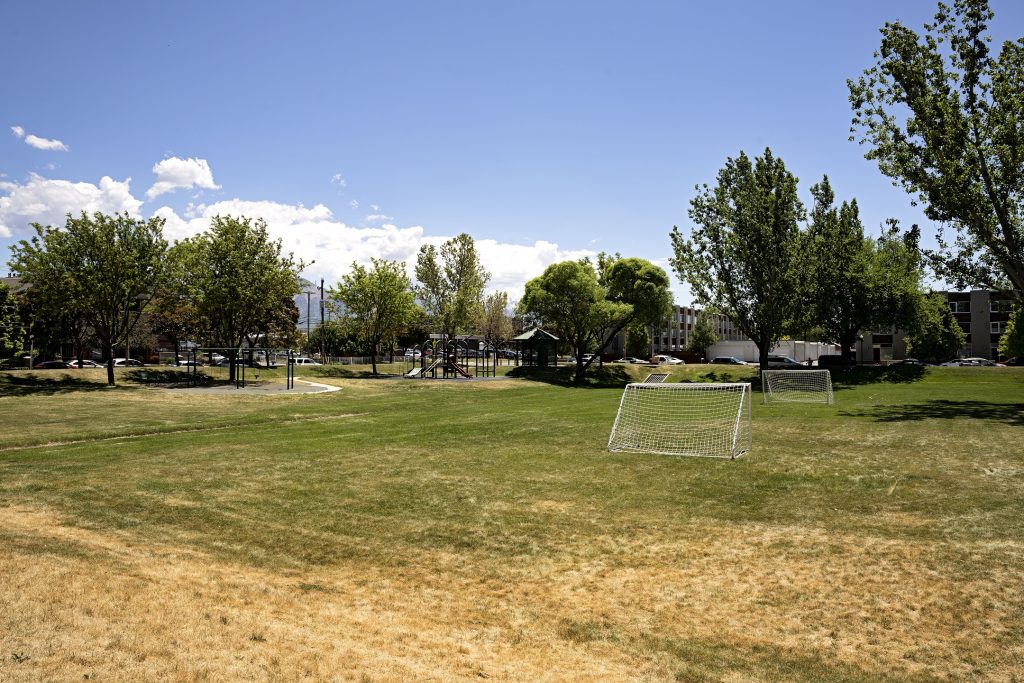In accordance with Mayor Erin Mendenhall’s Stage 2 Advisory of City’s Water Shortage Contingency Plan, Salt Lake City’s four Public Lands Divisions have established plans to conserve water during the ongoing drought.
Expand each section below to read more about what actions each of our divisions will be taking.
Parks Division
Parks Division Stage 2 Drought Plan:
- No watering between the hours of 10:00 am and 8:00 pm. The flower beds will see normal watering as the gallons of water needed is minimal as well as to protect the investment of purchasing the flowers.
- Except for newly funded CIP projects, no new seeding, sodding, or landscaping will be done within the Parks Division.
- Parks will perform a social media campaign to receive the public’s help with reporting irrigation breaks through City Source, e-mail, or phone.
- Implement additional staffing to repair broken sprinkler heads, minor irrigation line breaks in a timely manner so we reduce wasting water. When irrigation systems are running for repair, install signs indicating such.
- Communicate to our partners of the Stage II drought plan and their role to help conserve water.
- The priority for water use is for trees, sports fields, and special event areas. All common areas will be reduced to a level that prioritizes keeping grass alive rather than keeping it green, acknowledging that this will lead to yellow or brown grass in some areas.
- The Liberty Park Splash Pad will operate on a limited daily schedule from 12:00pm to 6:00pm.
- Parks will work to operate its facilities so that water use is reduced by 14% of the water budget per the mayor’s recommendations.
Stage 3 of the drought plan will incorporate the above plan as well as the following:
- Under the direction of Public Utilities, reduce water by 5 to 15%.
- Reduce water in common areas, islands, and green belts.
- Assign additional staff to water trees and landscape by hand.
- Turn off (or keep turned off) ornamental fountains.
Trails and Natural Lands Division
- Identify restoration efforts that can be achieved without the use of supplementary water, either using dryland restoration techniques, or conducting restoration around natural springs, seeps and wetlands.
- Support the separation of tree/shrub and grass watering zones for all irrigation systems installed in new capital projects and capital replacement projects involving irrigation, allowing future flexibility in watering regimes in cases of drought.
- Support the establishment of biodiverse native species in natural areas and restoration sites to enhance climate resilience of the SLC Public Lands system.
- Wash fleet vehicles and equipment less often.
- Continue to look for other approaches to support water conservation.
Urban Forestry Division
Short Term
- Coordinating with the Parks Division to enhance the efficiency and effectiveness of tree watering practices on City properties
- Monitoring trees that are receiving less water than normal to determine minimum watering needs
- Consulting with city residents on specific water options and instructions to preserve trees while conserving water
Long Term
- Researching new tree varieties that are more drought tolerant while still providing maximum shade
- Testing soil supplements and plant health treatments that may improve drought tolerance in trees
- Researching ‘tree specific’ irrigation system designs that can provide water to trees in a manner that optimizes uptake and minimizes waste.
Golf Division
Golf Division Drought Plan:
- Stage 1 – Begin programming adjustments of 5% to driving ranges and practice area. Reduce irrigation to out-of-play areas by a minimum of 10%.
- Stage 2 – Programming adjustments and reduced irrigation in nonessential play areas to reflect an overall usage reduction of 5% based on a 5-year average. Additionally, increase use of surfactants and organic products as necessary to maximize useable irrigation applied. Could sustain for 21 to 35 days with minimal impact to turf appearance, quality and playability.
- Stage 3 – Programming adjustments and eliminate nonessential play area irrigation (capping sprinkler heads or turning valves off) increase cutting heights, continue and possibly increase use of surfactants and organics. Efforts will reflect an overall usage reduction of 15% based on a 5-year average. Could sustain for 14 to 21 days with noticeable impacts to turf appearance, quality and playability.
- Stage 4 – Programming adjustments prioritized in order of importance (greens, tees, fairways and roughs) with hand watering of areas on greens and tees, further increases in cutting heights along with traffic control and continue with surfactants and organics. Efforts will reflect an overall usage reduction of 25% based on a 5-year average. Could sustain for 7 to 14 days before significant impact to turf quality and playability mostly in fairways and rough areas.
- Stage 5 – Programming adjustments prioritized in essential order (greens, tees, fairways and roughs) with supplemental irrigation, hand-watering areas of importance, maintain cutting height increases and decrease mowing frequencies and continue with surfactants and organics. Efforts will reflect an overall usage reduction of 35% based on a 5-year average. Could sustain for 7 days before turf loss in realized significant impact to turf quality and playability though out golf course.
Each course has different needs and resources. For example, Mountain Dell’s cutbacks will be more severe because their source is shared with Public Utilities and they are needing to drain Little Dell reservoir this summer for repair and maintenance. Nibley Park is a manually irrigated property and it is more difficult to control use.
